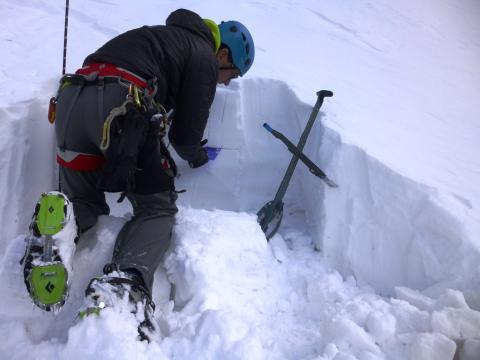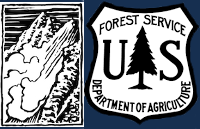Photos

|
Northern Gallatin, 2015-03-27 Pinwheels and rollerballs of snow indicate the snow surface is getting wet and loosing strength. As more of these start rollling downhill the danger of wet snow avalanches increases. Photo: GNFAC |

|
Northern Gallatin, 2015-03-19 This large chunk of snow was once perched precariously on the ridge above. As temperatures warm and cornices lose strength they will ultimately release naturally. It's a good idea to avoid slopes beneath large cornices and give them a wide distance along the ridgelines. Photo GNFAC |

|
Northern Gallatin, 2015-03-08 We went up Flanders Creek to the ridge to see how the wind-slabs that formed last week were reacting. Even though we found facets under the thin slabs (Eric is holding a piece of wind slab) , they were not unstable. Check out our video. Photo: GNFAC |

|
Northern Gallatin, 2015-03-06 "We triggered a medium sized wind slab about 50 ft wide and 12" deep. It released easily after I kicked a small piece of the cornice on it, the chunk was only about twice the size of a football. We're talking R1D1, maybe D2, but a person would have gone for a wild ride if they were stuck in it. The weak later seemed to be facets that formed near a thin crust that was buried by the wind slab. We had dug a pit less than 500 ft down at a similar aspect and didn't see any signs of concern. ECTX, CTN, and no noticeable weaknesses in the pack." Photo: A. Schauer |

|
Northern Gallatin, 2015-02-25 Mark demonstrates some advanced pit digging techniques. Step 1: Bury the sled. Step 2: Smooth out the trench wall. Step 3: Do a stability test. Step 4: Wait for your partner to come help you. Photo: GNFAC |

|
Northern Gallatin, 2015-02-22 Eric Knoff on top of Palace Butte in Hyalite on a windless, cold, winter day. Perfect. Photo: GNFAC |

|
Northern Gallatin, 2015-02-22 This small slab was triggered by a skier near Mt Blackmore in the northern Gallatin Range on Sunday 2/22/15. Although small, this type of slide can be dangerous, especially if triggered in steep, high consequence terrain. Photo K. Lalli |

|
Northern Gallatin, 2015-02-22 This natural avalanche was observed near Mt Bole up Hyalite Canyon. This slide likley released during or immediately after the storm that dropped nearly 20" of new snow in the northern Gallatin Range. Photo GNFAC |

|
Northern Gallatin, 2015-02-16 8" of new snow produced some small sluffs in steep terrain around Mt. Blackmore. Photo GNFAC |

|
Northern Gallatin, 2015-02-16 It was great to see snow on the trees and temps in the teens. It looked and felt like winter. Photo GNFAC |

|
Northern Gallatin, 2015-02-05 Many shallow natural avalanches were seen in Hyalite Canyon just south of Bozeman on Wednesday, Feb 4. These were breaking within the new snow about 4-6 inches deep. Photo: B. Vandenbos |

|
Northern Gallatin, 2015-02-03 Skiers triggered this small wind slab in a north facing chute up Hyalite Canyon on Monday, February 2. It broke 20 feet wide, 8-10" deep on a 45 degree steep slope. Photo: M. Cohen |

|
Northern Gallatin, 2015-01-21 8-10" of low density snow has accumulated in upper elevation terrain of the northern Gallatin Range. Photo GNFAC |

|
Northern Gallatin, 2015-01-21 The northern Gallatin Range received 8-10" of low density snow over the past few days. Moderate winds out of the W-NW were transporting the new snow onto leeward slopes. This type of transport was confined to upper elevation terrain and was not a problem on lower elevation slopes. Photo GNFAC |

|
Northern Gallatin, 2015-01-15 Once this wind slab released, it ran easily on top of a thin ice crust and entrained a lot of snow as it ran downhill about 700 feet vertical. Photo: GNFAC |

|
Northern Gallatin, 2015-01-15 Wind slabs on Wednesday (Jan 14) in Hyalite were very sensitive and easy to trigger. Mostly they were resting on low density new snow. This one was skier triggered and the cracked across most of the slope. It broke 5 inches deep. A crack can be seen in front of the skier near the top of the photo. This is a NE facing slope at 9500ft. Photo: GNFAC |

|
Northern Gallatin, 2015-01-01 The snowpack on Mt Ellis is looking surprisingly good for this time of year. Photo GNFAC |

|
Northern Gallatin, 2015-01-01 Cold clear nights and calm days have prompted the growth of surface hoar around Mt Ellis. These fragile, feathery crystals are easily destroyed by sun and wind, but can be a long standing problem if buried intact. With more snow in the forecast, this may become our next avalanche problem. Photo GNFAC |

|
Northern Gallatin, 2014-12-14 Over a foot of new snow fell in the northern Gallatin Range. This nearly doubled the snowpack in this area. Fortunately the storm came in warm and the new snow bonded well to the old snow surface. Facets near the ground were moist and unreactive in stability tests. Photo GNFAC |

|
Northern Gallatin, 2014-12-10 The sides of the gully are wind packed, dense slabs that are sitting on weaker facets. It took a lot of force to intiate a fracture (ECTP, 32), but it propagated which means avalanches are possible. Photo: GNFAC |
